Today’s Current Affairs: 16th Sep 2023 for UPSC IAS exams, State PSC exams, SSC CGL, State SSC, RRB, Railways, Banking Exam & IBPS, etc
Table of Contents
National Engineer’s Day 2023:

Engineer’s Day is celebrated in India on September 15 every year to honour the contributions of Bharat Ratna Sir Mokshagundam Visvesvaraya, also known as Sir MV, who was born on this day in 1861.
Sir M Visvesvaraya:
- Mokshagundam Visvesvaraya, widely known as Sir MV, was a distinguished engineer, statesman, and scholar who held the position of Diwan of Mysore from 1912 to 1918.
- He was known as the father of Modern Mysore for his outstanding contribution to society.
- He was born on 15th September 1861 in Muddenahalli village in Karnataka.
- He completed his Bachelor of Arts (BA) from the University of Madras and completed civil engineering from the College of Science in Pune.
- He was the chief engineer responsible for the construction of the Krishna Raja Sagara Dam in Mysore.
- He designed and patented automatic water floodgates in 1903, which were first installed at the Khadakwasla reservoir in Pune.
- In 1917, Visvesvaraya established the Government Engineering College in Bengaluru, which was later named University Visvesvaraya College of Engineering in his honour.
- He was a renowned precursor of economic planning in India.
- In 1955, the Government of India honoured him with the highest civilian honour — Bharat Ratna for his numerous industrial, economic and social projects.
- He was also conferred the British knighthood by King George V, earning the title “Sir.”
Advocate-On-Record:
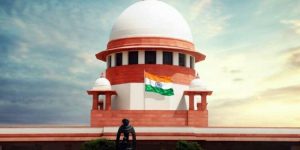
A Supreme Court (SC) Bench recently imposed a cost of ₹2,000 on an advocate-on-record (AoR) for sending a young junior to appear before the Bench without any papers.
- The concept of AoR was introduced by the SC with the power given to it under Article 145(1) of the Indian Constitution, which states that the SC may, from time to time, make rules for regulating the practices and procedures in the court.
“Advocate on record” is a title given to an advocate who can represent a cause or pleading before the SC. - Only these advocates are entitled to file any matter or document before the SC. They can also file an appearance or act for a party in the SC.
- No other High Court in India has a similar provision.
- Order IV Rule 5 of the Supreme Court Rules, 2013 lays down the requirements to be fulfilled to become an AoR.
- They are as follows:
- The Advocate is required to be enrolled with any State Bar Council.
- The Advocate is required to have a prior experience of at least 4 years.
- The Advocate has undergone a training of 1 year under a senior AoR.
- The Advocate has appeared for the examination conducted by the SC.
- The Advocate is required to have an office in Delhi within a radius of 10 miles from the SC house and give an undertaking to employ a clerk, who shall be a registered clerk, within one month of being registered as an advocate on record.
- Once registered, an AOR is issued a unique identification number that must be used on all documents filed in the SC.
World Lymphoma Awareness Day 2023:

World Lymphoma Awareness Day is observed every year on September 15.
- Lymphoma is a type of cancer that originates in the lymphatic system, which is a part of the body’s immune system.
- The lymphatic system includes lymph nodes, lymphatic vessels, the spleen, tonsils, and the bone marrow.
- Lymphomas are characterised by the abnormal growth and proliferation of lymphocytes, a type of white blood cell, which can form tumourstumors in various parts of the body.
- It’s considered a blood cancerbecause the condition starts in white blood cells (lymphocytes) in your lymphatic system.
Lymphomas can be aggressive (fast-growing) or indolent (slow-growing). - It can spread rapidly from the lymph nodes to other parts of the body through the lymphatic system. As cancerous lymphocytes spread into other tissues, the immune system cannot defend against infections as effectively.
- The cause of lymphoma is not fully understood, but it is thought to be caused by a combination of genetic and environmental factors.
- Signs and symptoms of lymphoma may include:
- Painless swelling of lymph nodes in the neck, armpits or groin
- Persistent fatigue
- Fever
- Night sweats
- Shortness of breath
- Unexplained weight loss
- Itchy skin
- The course of treatment depends on the type of lymphoma a person has and the stage it has reached
Storm Shadow Missile:
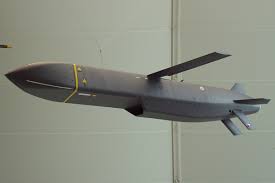
British-made Storm Shadow missiles were recently used in a Ukrainian strike that damaged a Russian submarine and ship at a major naval port in Crimea.
- Storm Shadow Missile is a long-range cruise missile with stealth capabilities jointly developed by the UK and France.
- The missile is intended to strike high-value stationary assets such as airbases, radar installations, communications hubs and port facilities.
- Able to be operated in extreme conditions, the weapon offers operators a highly flexible, deep-strike capability based on a sophisticated mission planning system.
- The Storm Shadow is also in service with the air forces of Egypt, India, Italy, Greece, Saudi Arabia, Qatar, and the United Arab Emirates (UAE).
- It is typically launched from the air.
- The missile weighs 1.3 tonnes and is just over 5m long.
- Powered by a turbo-jet engine, the missile travels at speeds of more than 600mph.
- It carries a 450kg conventional warhead to a range of up to 200 miles (300km).
- It is equipped with fire-and-forget technology and fully autonomous guidance.
- The missile is fitted with a passive imaging infrared seeker.
- The missile is programmed with every detail of the target and the path to be taken to reach the target prior to its launch.
- Once launched, the missile drops to a low altitude to avoid detection by enemy radar before latching onto its target with the infrared seeker.
Discontinuation Of I-CRR : RBI
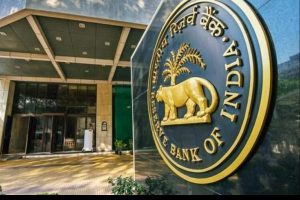
The Reserve Bank of India (RBI) announced that it would discontinue the Incremental Cash Reserve Ratio (I-CRR) in a phased manner.
- The central bank will release the amount that banks have maintained under I-CRR in stages.
- The discontinuation of the I-CRR will be implemented in stages to ensure a smooth transition and prevent sudden shocks to the system’s liquidity.
- In the first and second stages of the I-CRR reversal, 25 % of each of the Banks’ impounded funds will be released.
- The remaining 50% of the balance will be released in the third stage.
- This measured approach aims to ensure that banks have sufficient liquidity to meet increased credit demand during the upcoming festival season.
I-CRR:
- On 10th August 2023, following the announcement of the monetary policy and the demonetization of Rs 2000 notes, the RBI declared that banks would be required to maintain an Incremental Cash Reserve Ratio (I-CRR) of 10% on the increase in their Net Demand and Time Liabilities (NDTL).
- NDTL is the difference between the sum of demand and time liabilities (deposits) of a bank (with the public or the other bank) and the deposits in the form of assets held by the other banks.
- Stated that it would review it in September 2023, or earlier.
- The RBI introduced the I-CRR as a temporary measure to manage excess Liquidity in the banking system.
- Several factors contributed to the Surplus Liquidity, including the demonetisation of Rs 2,000 banknotes.
- RBI’s surplus transfer to the government, increased government spending, and capital inflows.
- This liquidity surge had the potential to disrupt price stability and financial stability, necessitating efficient liquidity management.
Leopard Sterilisation:

The Maharashtra Government has decided to sterilize Leopards for the sustainable management of population for leopards in the State.
- Gujarat’s forest department has also proposed sterilisation of leopards, especially in and around Gir National Park.
- In 2019-20 alone, Maharashtra saw 58 human deaths due to leopards—over half the 97 casualties in 2010-18.
- Maharashtra has decided to sterilize leopards as a response to the increasing leopard-human conflicts, rising leopard population, and the need to protect both leopards and human communities.
- The proposed sterilisation program aims to address these challenges while complying with environmental conservation laws and regulations.
- Concerns about the sterilisation of leopards include doubts about its effectiveness, the need for comprehensive scientific research, veterinary skill development, potential stress on leopards, challenges with traditional methods, and alternative contraception options.
- There is also an emphasis on addressing conflicts and gaining community support for conservation efforts.
Leopards:
- Scientific Name: Panthera pardus
- The leopard is the smallest of the Big Cats (Of genus Panthera namely the Tiger, Lion, Jaguar, Leopard, and Snow Leopard), and known for its ability to adapt in a variety of habitats.
- A nocturnal animal, the leopard hunts by night.
- It feeds on smaller species of herbivores found in its range, such as the chital, hog deer and wild boar.
- Melanism is a common occurrence in leopards, wherein the entire skin of the animal is black in colour, including its spots.
- A melanistic leopard is often called black panther and mistakenly thought to be a different species.
- Conservation Status:
- IUCN Red List: Vulnerable
- CITES: Appendix-I
- Indian Wildlife (Protection) Act, 1972: Schedule-I
Cybercrime Investigation Tool:

A new cybercrime investigation tool has been developed to track cyberattacks that target humans, such as insurance fraud and online matrimonial fraud.
- This tool, known as the TTP (tactics, techniques, and procedures)-based cybercrime investigation framework, aids in tracking and categorizing cybercrimes.
- It identifies the chain of evidence required to solve a case and maps evidence onto the framework to convict criminals.
- The technology can create an approximate crime execution path, suggest a crime path based on user-derived keywords, compare the modus operandi used in different crimes, manage user roles, and track activity for crime paths.
- By relying on criminals’ tactics, techniques, and procedures (TTPs), the TTPs-based investigation framework is expected to be highly effective in convicting cybercriminals quickly and precisely.
- The developed cybercrime investigation framework and tool are now ready for deployment with law enforcement agencies.
- This advancement is expected to make it easier to track and convict cybercriminals, ultimately reducing cybercrime activities in the country.
OIML (International Organisation of Legal Metrology) Certificates:

India has become the 13th country in the world that issue Internationally Accepted OIML (International Organisation of Legal Metrology) Certificates.
OIML (International Organisation of Legal Metrology) Certificates:-
- OIML (International Organisation of Legal Metrology) is a renowned international standard-setting body in the field of legal metrology.
- Established: 1955.
- HQ: Paris.
- Its primary role is to develop model regulations, standards, and related documents for use by legal metrology authorities and industries worldwide.
- These standards are crucial in harmonizing national laws and regulations concerning the performance of measuring instruments, such as clinical thermometers, alcohol breath analyzers, radar speed measuring instruments, ship tanks at ports, and petrol dispensing units.
- India became an OIML member in 1956.
- India signed the metric convention, emphasizing its commitment to international standards in metrology.
- The OIML-CS (Certificate System) is a globally recognized system for issuing, registering, and using OIML certificates, along with their associated OIML-type evaluation/test reports.
Advantages:-
- Indian manufacturers can now export their products with greater ease.
- The certification services provided by India will attract international manufacturers.
- To meet the growing demand for certification services, India is expected to witness a surge in employment opportunities in the legal metrology sector.
National Judicial Data Grid (NJDG) Portal:
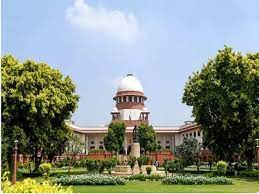
The Chief Justice of India announced the onboarding of the Supreme Court on the National Judicial Data Grid (NJDG) in open court.
- The NJDG portal is a national repository of data relating to cases instituted, pending and disposed of by the courts across the length and breadth of the country.
- In this portal, one may access case-related information, statistics such as institution, pendency, and disposal of cases, case types, and year-wise break-up of the Supreme Court of India.
- It is a database of orders, judgements, and case details of 18,735 District & Subordinate Courts and High Courts created as an online platform under the e-Courts Project.
- It has been developed by the National Informatics Centre (NIC) in close coordination with the in-house software development team of the Computer Cell, Registry with an interactive interface and analytics dashboard.
- The entire database will be periodically updated on the NJDG portal.
- NJDG works as a monitoring tool to identify, manage, & reduce the pendency of cases.
- It helps to provide timely inputs for making policy decisions to reduce delays in disposing of cases and reduce case pendency.
- It also facilitates better monitoring of court performance and systemic bottlenecks and, thus, serves as an efficient resource management tool. To track cases related to land disputes.
DiCRA Platform:

The United Nations Development Programme (UNDP) and the National Bank for Agriculture and Rural Development (NABARD) have signed a Memorandum of Understanding (MoU) to co-create data-driven digital public good, which includes DiCRA.
- Data in Climate Resilient Agriculture (DiCRA) is a collaborative digital public good which provides open access to key geospatial datasets pertinent to climate resilient agriculture.
- It is curated by UNDP and partner organisations to inform public investments in agriculture and already provides intelligence on climate resilience for 50 million hectares of farmland across India.
- It is guided by the digital public good principles of open access, open software, open code, and open APIs.
- It uses cutting-edge data science and machine learning to identify farms that are resilient to climate change and those that are highly vulnerable.
- Advantages:
- By partnering to enhance and scale its use, NABARD will host and maintain the DiCRA platform and use its key geospatial datasets for policymaking, research, and development activities, with UNDP’s technical support.
- This five-year technical cooperation is envisaged to foster collective climate action and create innovative platforms and new product offerings to enhance economic empowerment in rural India.
- Such open data innovations can highlight best practices, optimise agriculture investments and shelter populations from risk.
18th East Asia Summit:
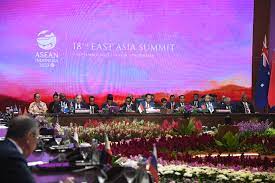
Prime Minister attended the 18th East Asia Summit (EAS) was held in Jakarta.
18th East Asia Summit (EAS):
- At the 18th EAS, the Leaders’ Declaration on ASEAN as an Epicentrum of Growth was adopted.
- It was discussed on building resilience against emerging challenges and future shocks through cooperation on enhancing energy security and food security, maintaining financial stability, and strengthening regional health architecture.
- The Plan of Action (POA) for the next five years outlines the priorities that include efforts on the mainstreaming and implementation of the ASEAN Outlook on the Indo-Pacific (AOIP).
- It lays emphasis on strengthening partnerships, through cross-sectoral collaborations that includes efforts in furthering the implementation of the 2030 Agenda for Sustainable Development.
- The meet provided an opportunity for ASEAN member states and the eight non-ASEAN countries to exchange views on issues concerning the region and the world at large.




